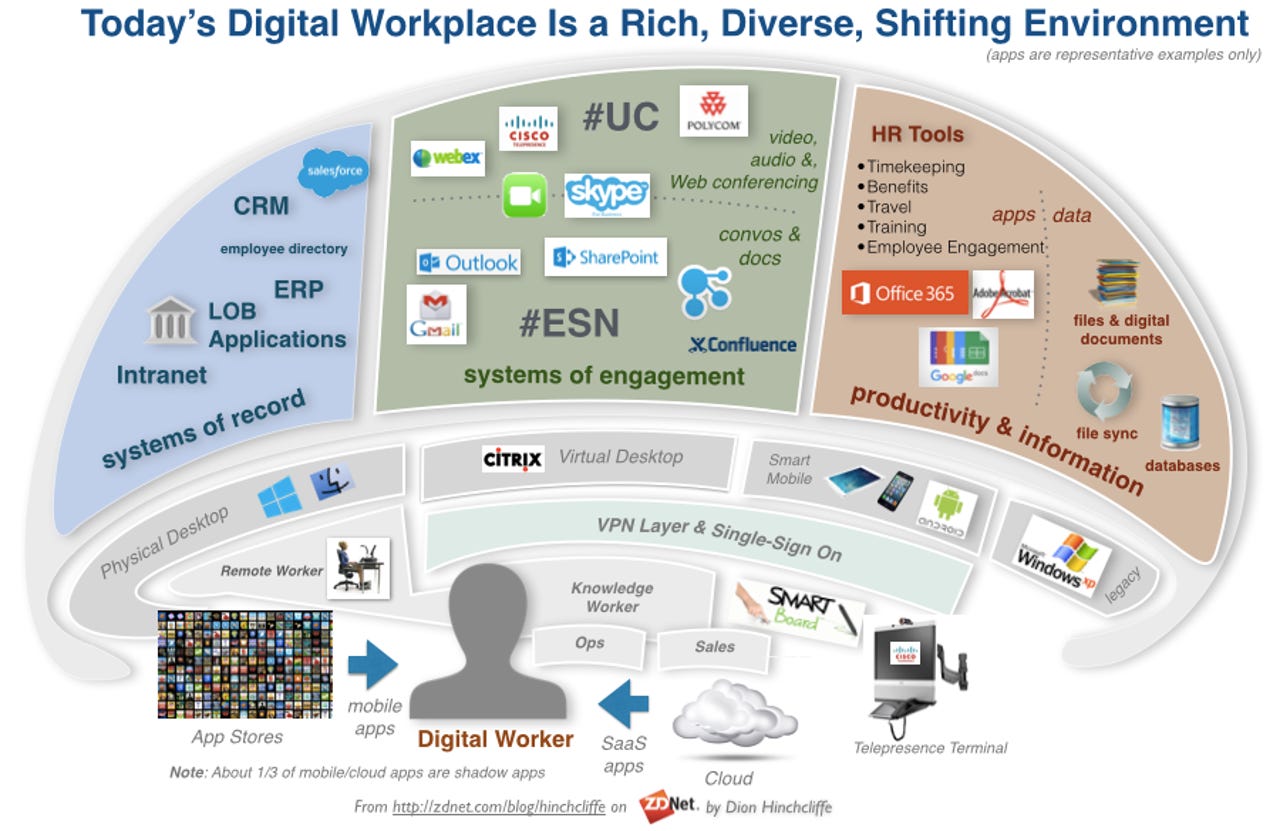Can we achieve a better, more effective digital workplace?

With so much of our business work being done today within digital environments, the overall user experience of the digital workplace as an entity in its own right has recently reached major organizational significance.
Put simply, providing an easy-to-understand and employ digital toolkit that's well thought-out genuinely matters in today's complicated and fast-moving work environments. Key business indicators, from the levels of worker productivity and efficiency to employee engagement and retention, are all meaningfully affected by the nature and quality of the digital tools that are put into workers' hands.
However, it's not the individual tools themselves -- which on the whole are becoming more powerful and easier-to-use than in previous years in my experience -- that has become the new strategic design challenge. (Though it's also true that individual tool and platform battles still abound as well.)
Instead, it's the overall picture of the ever-more elaborate -- yet largely accidental digital workplace -- that has become a leading issue as technology becomes an integral part of so much of what we do in our organizations. I now regularly encounter CIOs and heads of HR coming together ever more consistently to grapple with this issue: Workplace complexity and rapid change.

The challenges of today's digital workplace
A few key observations will perhaps help to illuminate the situation that most enterprises find themselves in today in terms of how they make digital tools available to workers:
- The amount of applications and devices workers have to use today to get their jobs done is at an all time high. Anecdotally, from my own work with large enterprises, this has jumped from one primary work device a decade ago, to 3 or more on average today (desktop, laptop, smartphone, and tablet), and from 10-15 applications to 30-50 applications during an average work week.
- Workers are increasingly using the digital tools they prefer, sanctioned by IT or not. So-called "shadow IT" now makes up between a third and half of all IT today, with 61% of organizations supporting it in some way, according to research I published with IBM recently. Especially on the edge of the organization, this is greatly increasing the number of applications in use.
- Workforce communication and collaboration tools have been proliferating at a nearly steady and very bustling rate over the last half-decade and more. I've been receiving e-mails from new startups and product companies launching something this space an average about once a week for almost a decade now. As a result, there is a great crowding in the space today and many of these solutions are used at departmental levels for the special functions they offer a given activity, and offer real benefit.
- Employee engagement remains stubbornly low -- Gallup recently reported the dismaying data that only one in 8 workers was fully committed psychologically to their job -- and now dozens of new technology products are emerging to address this vital workforce issue, adding even more digital solutions to the workplace, according to the Society for Human Resource Management. This leads to two issues: One is that unengaged employees don't really care much about a terrific digital workplace an organization might have created. Consequently the lion's share of the overall investment in it is actually squandered. Two, they won't seek to make the most of those digital tools, no matter how powerful or effective.
- We've essentially lost the "front door" of the digital workplace as digital workplace guru Paul Miller recently called it, as the steady encroachment of SaaS and native mobile apps have consistently chipped away at our official approved productivity and communication tools. These now come at us sidewise or through the back door, via viral links to SaaS-attached documents or shadow IT apps on our smartphone. Many of us now get pulled this way at work into farflung parts of the the cloud and will spend as much time in Google Docs and other external cloud suites as we do Office365, or whatever our official workplace productivity tool is. I noted the same problem with communications and collaboration earlier this year: Pervasive channel and app proliferation, combined with a thorough and disappointing lack of tool interoperability that at this point simply ought to embarrass the tech industry, is increasingly siloing and fragmenting team work and conversation, instead of helping it.
- Newer digital tools in the workplace are often hard to find and/or understand in terms of the best application for a given purpose. The front door, which should be the virtual shelf were all the digital tools sit and can be found, hasn't been keeping up, and often the best new solutions, which exist and are supported, have a low level of awareness and accessibility.
- The elements of the digital workplace today -- which we have traditionally not spent much time designing as it was even until recently a fairly simple place dominated by one or two official applications at most for a given category -- has become much richer, looser mix of incrementally acquired official apps and line of business/worker curated but unsanctioned solutions that neither don't fit together well nor feel like the internal experience that has some kind of workable design center or plan to accommodate. While I'm very much not suggesting that organizations seek overarching, highly controlled digital workplace designs, quite the opposite, it's now vital that we do a much better job assembling, positioning, presenting, educating, integrating, managing and supporting a more cosmopolitan digital workplace than we've ever had previously. In other words, we have to design today's digital workplace for a high level of diversity, frequent change, and lack of control.
Digital workplace habitats, not jumbles of apps
From all this, it's now apparent that as organizations sit back today to reconsider their current internal digital landscape of worker-facing applications and systems, it's vital that we seek new and more practical models for thinking about the digital workplace. It's time to realize that we have entered a new reality with digital applications and services.
Our workers' digital toolkit is no longer a monolithic set of official apps and systems, but rather an ecosystem of solutions that must be brought together more dynamically, made accessible, secure, and safe, and evolved in a coherent manner. Most importantly, the result must made readily understandable and accessible to the average worker, as their digital skills are also improved to take advantage of the possibilities of todays new digital capabilities.
To do anything less is to continue to raise the level of cognitive load on workers, and ensure that ever-more incremental improvements and diminishing returns are the only possible result as digital tools continue to enter the organization and pile up with being properly situated and supported.
My friend and industry colleague, the noted digital workplace expert Jane McConnell almost certainly summed it up best recently, based on hard data she has collected in the industry, about the shift from a single inflexible comprehensive digital workplace solution to a more orchestrated and nuance ecosystem approach that would work better over time:
The single magic solution is on the way out. Ecosystems are the longterm platform vision for digitally maturing companies.
Most orgs have already concluded the digital workplace must be a coordinated ecosystem, yet reality hasn't caught up this understanding. Source: Jane McConnell.
The new digital workplace: Ecosystems and dynamic adaptability
While I've called for organizations to strongly consider multi-layered collaboration strategies recently, it's now time to take this model up a level to the entire digital workplace. Our efforts at crafting a vision and design for our new digital toolkit must be resilient frameworks and other new IT approaches, not fixed designs, and accommodate frequent change at the margins and recognized the reality that there is no single IT solution for most business needs any more. From Jane's data above, it's clear that this is already happening in a significant way: Most are reporting today that they are becoming miniature application ecosystems in their own right. The key is in ensuring ingredients that work together at least reasonably well and don't force a lowest-common denominator and once-size-fits-all mentality, which is the very definition of mediocrity.
It turns out, this reality actually aligns very well and is consitent with the other macro changes that the digital world has wrought in an era of exponential change: The realization of mass customization and personalization, self-service, tapping into today's do-it-yourself zeitgiest, and the empowerment of individuals as effective change agents that have autonomy and authority to improve the organization around them. Digital workplace efforts that take these lessons to heart are much more likely to achieve sustainable results and reach their goals.